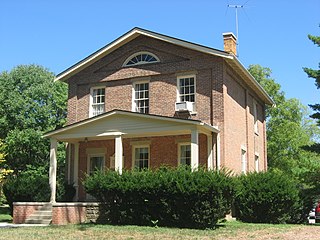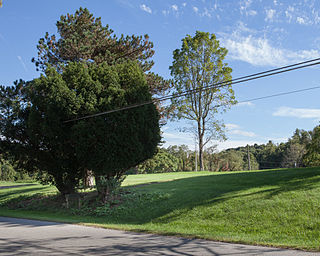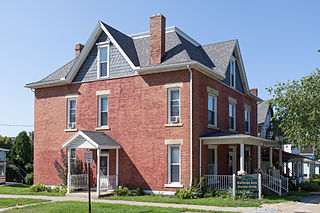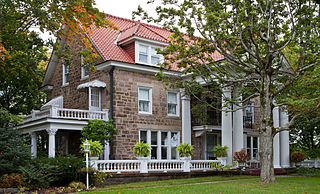
Monongahela, referred to locally as Mon City, is a third class city in Washington County, Pennsylvania, United States. It is part of the Pittsburgh, PA Metropolitan Statistical Area, and is located approximately 17 miles (27 km) south of the town proper. The population was 4,300 at the 2010 census.

Edward Goodrich Acheson was an American chemist. Born in Washington, Pennsylvania, he was the inventor of the Acheson process, which is still used to make Silicon carbide (carborundum) and later a manufacturer of carborundum and graphite.

Langstroth Cottage is a historic building on the Western College campus of Miami University in Oxford, Ohio. It was designated a National Historic Landmark on June 22, 1976. The cottage, built in 1856, is now the home for the Oxford office of the Butler County Regional Transit Authority. It was purchased for Beekeeper L. L. Langstroth in 1859, and he lived there for the next 28 years, conducting research and breeding honey bees.

The David Espy House is a historic house at 123 East Pitt Street in Bedford, Pennsylvania. Built in 1770, it is significant as the residence used by President George Washington when he was leading the troops that put down the Whiskey Rebellion in 1794. It was declared a National Historic Landmark in 1983. The house is now used for commercial purposes.

The Roberts House is a historic building in Canonsburg, Pennsylvania, listed on the National Register of Historic Places. It is designated as a historic residential landmark/farmstead by the Washington County History & Landmarks Foundation. The Greater Canonsburg Heritage Society erected a historical marker near the house, which is the last remaining structure from Jefferson College.

The Dr. Joseph Maurer House is a historic house in Washington, Pennsylvania.

The Sackville House was a historic building in East Washington, Pennsylvania. It was located at 309 East Wheeling Street in Washington, Pennsylvania before it was demolished in 1980.

Samuel Brownlee House is a historic building in Washington, Pennsylvania. It is designated as a historic residential landmark/farmstead by the Washington County History & Landmarks Foundation.

Thomas Munce House is a historic house in South Strabane Township, Washington County, Pennsylvania. The earliest section was built in c. 1794 with additions in c. 1810 and 1835. The house is 2+1⁄2-story, stone, vernacular, Georgian-influenced with a gabled roof and a façade with five openings. The house is representative of the more substantial second-generation houses built to replace earlier log houses in Washington County.

Montgomery House is a historic building in Claysville, Pennsylvania.

Cement City Historic District is a historic district in Donora, Pennsylvania. The district includes 80 Prairie School concrete residences built in 1916–17. The homes served as housing for employees of the American Steel and Wire Company. Poured-in-place concrete houses had become popular in large-scale housing developments at the time, partly thanks to promotion by Thomas Edison; the homes built in Donora used a newly patented construction method from the Lambie Concrete House Corporation. Building the houses required a combined 10,000 barrels of Portland cement.

Philip Friend House is a c. 1807 historic farm house in North Bethlehem Township, Pennsylvania, US. The stone house is forty feet by thirty feet, two-story, five-bay, and gable-roofed. Contributing outbuildings include a barn, springhouse, wash house, and privy.

Molly Fleming House is a historic building in California, Pennsylvania.

Dusmal House is a historic building in Gastonville, Pennsylvania. It is a three-bay, 2+1⁄2-story house built in 1839. A one-story addition was added later in the nineteenth century. The historic significance of the house is as an example of the Post Colonial style of architecture found in Western Pennsylvania. Vernacular builders mixed elements of Georgian, Roman Classical, Adamesque, and European Renaissance styles as they saw fit, differing from traditions in other parts of the country.

Harrison House was a historic building in Centerville, Pennsylvania. It was built c. 1845 as a Post Colonial Greek Revival house, and later updated to a High Victorian Italianate style. The five-bay 2+1⁄2-story structure with a two-story bay window unit with a turret roof and a four-story tower was unusual for the Washington County, Pennsylvania area.

Jennings–Gallagher House is a historic building in California, Pennsylvania.

David Longwell House is a historic building in Monongahela, Pennsylvania.

Welsh–Emery House is a historic building in Richeyville, Pennsylvania.

John White House is a historic building in Chartiers Township, Washington County, Pennsylvania.
Bellefonte Academy was a historic school building located at Bellefonte, Centre County, Pennsylvania. The original building was built in 1805, as a two-story, rectangular limestone building. It was enlarged between 1839 and 1845, with the addition of two bays and wings to the north and south. After a fire in 1904, the building was rebuilt with the addition of a third story and the addition of a portico with six Tuscan order columns and Classical Revival style details. The wings were enlarged in 1913. Also on the property was the headmaster's house.























